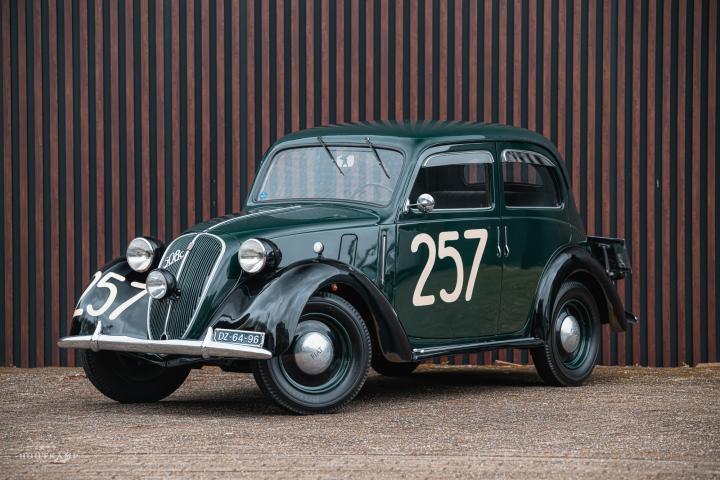Mille Miglia Eligible
Veteran car 1947 and 1949 Mille Miglia
As a car from 1939, has the plus of placing early on the starting line
The first car powered by methane gas participating in the Mille Miglia and in a motor race
The detail of the hand painted original Mille Miglia race number is off-course amazing
With an exceptionally large amount of documents from the archive of the Mille Miglia Museum in Brescia, approximately 40 pages!
A very collectible automobile. The market is small and highly specific, but so is the supply
The opportunity to acquire a piece of Mille Miglia history at a reasonable price
It was introduced in 1937 as Fiat 508 C or Balilla 1100, as a replacement for the Fiat 508 Balilla.
The 508 C had more modern and refined mechanicals compared to the 508, including independent front suspension and an enlarged overhead valve engine.
It was in production until 1939, it costed LIT 19.500 and was produced in the Cabriolet, “Berlina” and “Berlina tetto apribile” (open top) versions.
The engine was the Fiat 108C, a straight 4-cylinder 1089 cm³OHV (hence the nickname 1100) with a 4-speed gearbox.
The power has increased by one third, to 32 hp at 4.000 rpm, capable of pushing the car at 95 km/h. At the time, its comfort, handling and performance were stunning, making it “the only people’s car that was also a driver’s car”.
Indeed, the 508 C was brought to the race, even at the Mille Miglia.
Methane as the main component of marsh gas was first discovered in 1776 by an Italian scientist Alessandro Volta, though it did not become widely used in different aspects of everyday life until 19th century.
People had to wait even longer to use it in the automotive industry – until 1930s.
The financial crisis of 1929 pushed people to creating natural gas supply systems. Faster development of gas supply systems in cars was also helped by the fact that petroleum had to be imported to Italy and the country’s policy was to aim at self-sufficiency in engine fuels.
Unlike today, when methane compression stations are popular, back in those days distribution of this type of fuel was carried out by replacing empty cylinders for filled ones, which made sense, especially in the areas without gas network.
From this situation the idea of the Driver Armando Bevilacqua, owner of a methane gas trading company in Bologna, to convert his standard Fiat in a Methane version for racing the Mille Miglia, to show to the Italian public the high performance of a methane car.
ABOUT THIS SPECIFIC EXAMPLE
At the 10th of April 1939 the Fiat was delivered to its first Italian owner, in Bologna.
Subsequently it was sold in Bologna the 10th of April 1942 to Mr. Armando Bevilacqua, he was the Mille Miglia driver.
Mr. Armando Bevilacqua was the founder of a methane gas trading company “Rifornimento Matano Bevilacqua” in Bologna.
The company transported methane gas in cylinders for civil and industrial uses with its own trucks. The company still exist today, is run by the son, Alfredo Bevilacqua. The company name changed in AB Motor and is based near Modena.
Mr. Bevilacqua was an excellent racing driver and he can be described as a veteran, in fact he participated in 10 Mille Miglia editions, from 1947 to 1956.
In 1947 and 1948, the Fiat was raced at the Mille Miglia with Mr. Bevilacqua as driver and Mr. Carboni as Codriver, together with the car there are old photos of the car during the Mille Miglia and an incredibly large amount of original documents from the archive of the Mille Miglia Museum in Brescia, approximately 40 pages!
This specific example was the first touring car with an engine powered by methane gas participating in the Mille Miglia.
It was also the first time in Italy that a methane car attempted a motor race.
The car, a standard 4-seater Fiat Berlina 1100 touring car, with absolutely normal bodywork, engine and accessories, was powered by natural methane gas, produced by the Castagno mine (Florence) by the Società Idrocarburi Nazionali.
The cylinders containing methane were two with a capacity of 40 litres each, were installed at the rear of the car, standing, slightly inclined, leaning against the bodywork, just as they are commonly installed on cars converted to methane.
The interchange at the refueling stations was made quicker by a system of fastening of the cylinders to the bodywork of the car.
The normal construction head of the engine was simply lowered in order to increase the compression ratio, bringing it from 6, (normal for petrol) to 7.5, thus exploiting as much as possible the anti-knock characteristics of methane without having problems with the ignition.
No other modifications had been made to the engine and accessories.
During the race no substantial inconvenience was encountered in the use of methane in the engine.
Along the route, 7 refueling stations have been established at a distance between a minimum of 203 Km for mountainous sections, to a maximum of 256 Km for completely flat sections.
The official time for the entire route of 1.823 Km was 23 h, 04′ and 28”, corresponding to an hourly average of 79 Km/h, significantly higher than the category minimum established at 75 Km/h.
For the special classification on the Turin-Brescia motorway, on a sector of 218 Km, the time was 2h, 20′, 18” at an hourly average of approximately 93,600 km.
The crew reached 40th place in the overall ranking and 20th in its “Sports” class .
Interesting, it would have reached the 6th place if it had been classified in the more suitable “Touring” class. Instead, in accordance with the regulations, the cars with modifications could take part just in the sports category.
The car is fully maintained, had a new balanced drive shaft installed and the gearbox serviced for the 2022 Mille Miglia. It is prepared and ready to take part in the 2024 Mille Miglia.
This specific example took part in the 2021 and 2022 Mille Miglia with two Dutch car enthusiasts. Due to the origin year 1939, it started with Number 116, which was a Start Time in the first 40 minutes of the race.
For a driver skilled in Time Trials and Average Speed Trials, and with a high and desirable 1.60 coefficient, (car coefficients in the Mille Miglia are between 1.10 and 1.80) the car is well capable to finish the Mille Miglia in the top 50 of the race.
This historically significant Fiat comes with FIVA Class A3 Passport, old photos of the car during the Mille Miglia, copies of original Mille Miglia documents and copies of the Italian registrations in the 40’s with mentioned the name of the Driver, Mr. Armando Bevilacqua.
Due to the purchase from the former Dutch owner of an other car in our collection, the Fiat 508 is waiting for a new owner who will continue the unique history of this car.
CONDITION EXTERIOR
The beautiful lines of its body showing a restrained elegance, the car presents well in Green over Black with a beautiful Grey cloth interior.
The exterior of this Fiat has been finished with a nice but slightly patinated paint.
Doors open and close smoothly and various bright work throughout the exterior have been polished and finely detailed to complement the deep Green paint where the detail of the hand painted original Mille Miglia race number is off-course amazing.
CONDITION INTERIOR
The bold and elegant exterior is further enhanced by the art deco influenced interior.
Once seated inside, the car is surprisingly roomy and open due to the expansive glass and light pillar work.
The door panels and seats are covered in contrasting Grey beautiful cloth.
The dashboard is a wonderful display of fully functional instruments and indicators.
DRIVING EXPERIENCE
The car starts and runs very well, the battery was recently replaced and the gearbox shifts very well, provided respect is paid to correct shifting technique, and the electrical system is in good condition.
Beautifully presented throughout, will be a welcome entrant at the 2024 Mille Miglia edition next June where the car is already subscribed.
This rare Fiat 508C offers a unique opportunity to acquire a piece of Mille Miglia history and a very special car that is eligible for the Mille Miglia and is offered at a fraction of the cost of other models.
Its rarity, its history, but also its early position on the starting line make this vehicle a very good choice for a subscription in the Mille Miglia.
HISTORY FILE
The Fiat 508C has a very impressive history file.
Included in the history file are amongst other papers:
Pictures of the period Mille Miglia
Copy of the subscription documents of the 1947 and 1948 Mille Miglia
Fiva Certificate
Mille Miglia Registro Certificate
The Mille Miglia Registro is the official Certifying Body that registers and certifies all cars that are eligible to enter the 1000 Miglia Storico (the modern Mille Miglia).
This specific Fiat 508 C has been Certified confirming this car is indeed an original Mille Miglia Veteran car and has participated in the 1947 and 1948 Mille Miglia.




